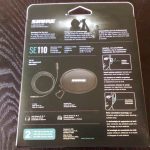
So here is my simple breakdown of some of the key things that are often stated in the specifications. Note that sometimes these are still quite meaningless, so don’t think that you’ll become an expert at discerning earphone qualities from reading this page.
Frequency Response: This is the range of frequencies at which the earphones can reproduce. Most people can hear in the range of 20Hz to 20KHz. The wider the range of frequencies that the earphone can reproduce, the better it is. Unfortunately, this is only half the story. The big question of “how well” the frequencies are reproduced can only be told by a frequency response graph plot, and this is something often not provided. You can imagine how silly it is if a earphone can produce 1KHz sound frequency “very loud and clear”, while both 20Hz and 20KHz come out somewhat weak, but it could still lay claim to a 20Hz to 20KHz frequency response.
Impedance: This is the resistance or “load” that is presented to the amplifier (i.e. the audio system). It seems to be not important to solid state amplifiers (such as iPods and MP3 players). A lower impedance earphone would draw more current, while a higher impedance earphone would require more voltage to drive it. But considering that all earphones are very low impedance anyway (16 ohms to 64 ohms typically), I doubt any of these have any noticeable impact. At any rate, when looking around for earphones, go for those between 16 ohms to 32 ohms.
Sensitivity: This is related to the perceived “loudness” of the earphone. The measurement is usually in db/mW. The more sensitive (higher db/mW value) a earphone is, the louder it sounds. You should probably look for something above 100 db/mW. I think it’s good to get a pair of sensitive earphones, so you don’t have to turn up the volume so high. Actually, the actual loudness could still be the same, but then it feels good that you could turn it up even louder if you wanted to. Heh.
So that’s basically it in terms of numerical specifications that you can compare. But there are a few more earphone characteristics that are worthwhile to note.
The “type”: For lack of better word, what I mean here is whether the earphone is in-ear, on-the-ear, around-the-ear (headphones), etc. I’ve become very “pro” for the in-ear earphone designs in combination with memory foams. In-ear phones go literally into your ear, and not just rest on your outer ear. Most people know what the silicon ear tips are. Memory foam is something better: It’s soft foam that you can squeeze into a smallish tip, insert into your ear canal, then let it expand out to fill out all the spaces in your ear canal. The result is that you get a very fitting and comfortable earphone. In-ear earphones with memory foams also offer the advantage that they block away outside sound, and the sound is delivered straight into your ear canal, so you hear your music very clearly without any of the distraction from background environmental noise.
Driver: This is about how the sounds is produced, as well as also the number of driver units. A detailed comparison of all the kinds of drivers is definitely beyond the scope of this page (and my expertise). The number of driver units is easier to explain: This is like having multiple sub-speakers, such as one for high-frequency sounds, another for mid-range and a sub-woofer for low frequencies. Most earphones only have one driver though. If you are concerned about the drivers, you should probably Google around for more in-depth discussion.
